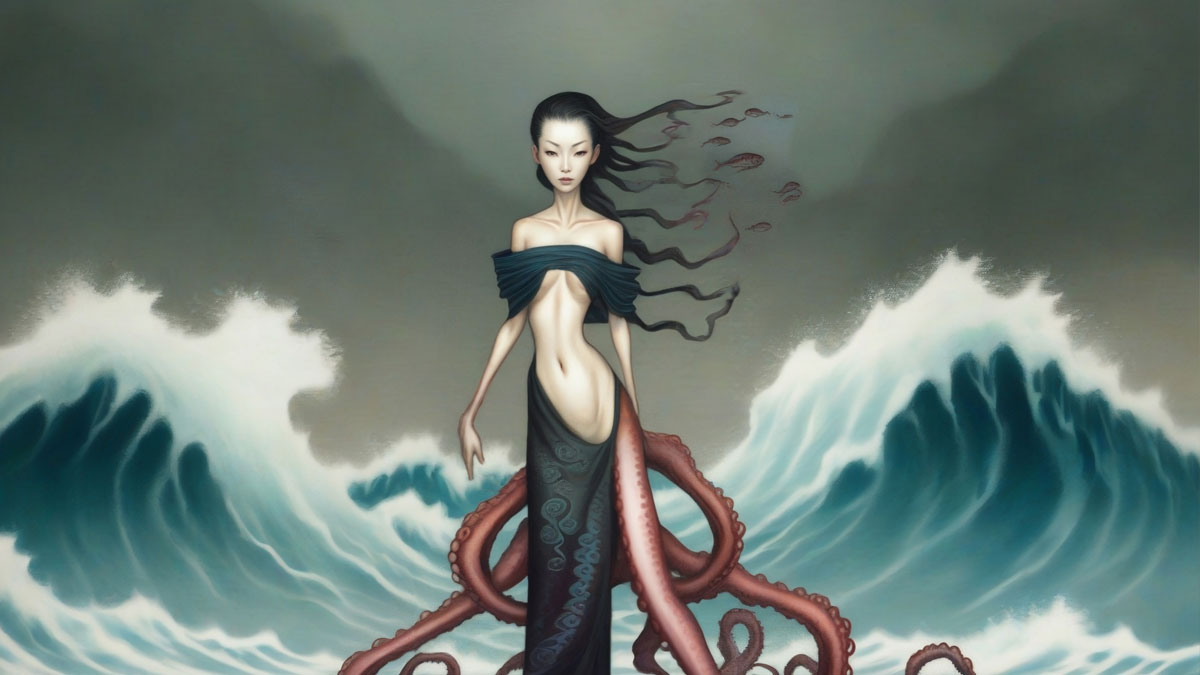The Akkorokamui is a sea monster from Ainu folklore. The Ainu regard it as a water spirit or deity.
The Ainu are an ethnic group native to the northern islands of the Japanese archipelago, including the island of Hokkaido.
The Akkorokamui allegedly lives in Uchiura Bay (Funka Bay), southeast of the island of Hokkaido. However, there have also been reports of the monster from waters off the coast of Korea and Taiwan.
Akkorokamui is the Japanese language version of the name. In the Ainu language, it is Atkor Kamuy.
The name reportedly means “the Kamui (spirit or divine being) with tentacles.” Some sources translate it as “Kamuy with strings,” a reference to the creature’s tentacles.
The legends often portray the creature as female. Thus, one of its best-known names is Ashketanne Mat (woman with long fingers).
Description
Folklore describes the Akkorokamui as an octopoid monster. Some accounts describe it as a half-woman, half-octopus sea creature.
Folklorists compare it to the Kraken, a sea monster from Scandinavian legends.
Alleged eyewitnesses said the Akkorokamui was a gigantic sea creature that could grow up to 390 feet in length.
It was so big that it could swallow boats whole. The Akkorokamui fed on other sea monsters, such as whales. It also fed on small sea creatures, such as fish, crabs, fish, and mollusks.
Legend says that the Akkorokamui is red in color. Folklore compares the color to the setting sun reflected on water.
When the Akkorokamui approaches, it looks as if the sky and sea have turned a deep red hue. Thus, seamen and fishermen panic when the sky has a reddish tinge before they believe it could mean that the Akkorokamui is approaching.
Origin Story
An Ainu legend traces the origin of Atkor Kamuy (Japanese: Akkorokamui) to the giant spider Yaushikep. Yaushikep (Yaoshikepu) lived in the mountains, and everyone feared it because it was vicious and aggressive.
Once, it attacked a village in Hokkaido known as Rebunge, causing widespread damage to property and loss of lives. In terror, the people pleaded with the gods for help, and Repun Kamuy, the sea god, responded.
Repun Kamuy lured the spider into Uchiura Bay (Funka Bay) and transformed it into an octopus. And that was how Akkorokamui became the lord or resident deity of Uchiura Bay.
The octopus grew in size after Repun Kamuy turned it into an octopus. It grew and became more and more ravenous. It swallowed sea monsters and menaced maritime traffic.
She once swallowed a large sea vessel full of people. Repun Kamuy heard the screams of the people and punished Akkorokamui by using a powerful venomous substance that caused the monster great pain.
The victims escaped when the Akkorokamui opened her mouth to scream in agony.
The Akkorokamui is a deity
Shinto religious tradition reveres the Akkorokamui as an octopus deity or kami (god or deity) of healing and spiritual knowledge.
Shinto legend sometimes portrays it as a deity. It may have a harmful influence due to its whimsical and capricious ways. Once the creature entraps a victim, it is almost impossible to escape because it has many arms or tentacles.
If you cut off a limb, it grows another one. Thus, the belief that the creature has healing powers.
Sightings and Tales
Author John Batchelor in The Ainu and Their Folklore 1901), a sea monster attack against a village.
Fishermen were out at sea fishing for swordfish when a giant sea creature with huge eyes attacked their boat. The monster discharged a dark fluid with a dreadful odor, and the fishermen fled in terror.
| Other Name/s | Atkor Kamuy, Ashketanne Mat |
| Location | Japan, |
| Type | Sea Monster |
| Habitat | Ocean |
References
Handbook of Japanese Mythology (2003), by Michael Ashkenazi
https://www.lrb.co.uk/the-paper/v39/n17/amia-srinivasan/the-sucker-the-sucker, “London Review of Books. The Sucker, the Sucker!” Amia Srinivasan, accessed on March 15, 2023.
https://archive.org/details/ainutheirfolklor00batcrich?view=theater#page/530/search/sword-fish, “The Ainu and Their Folklore,” (1901) accessed on March 15, 2023.
https://yokai.com/akkorokamui/, “Yokai: Akkorokamui,” accessed on March 15, 2023.
